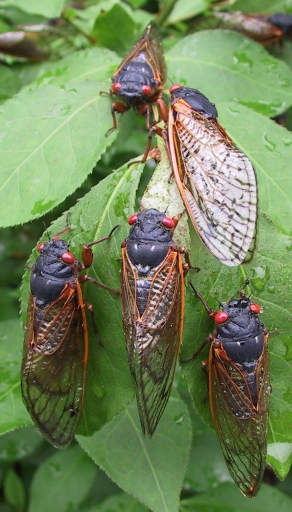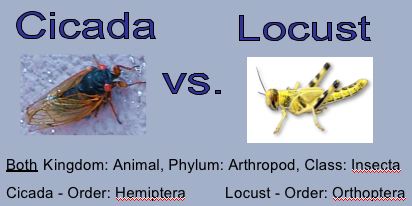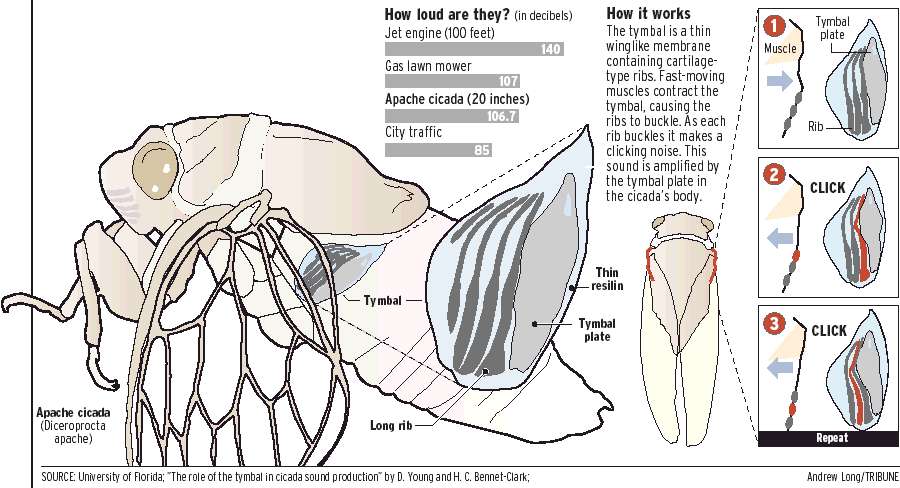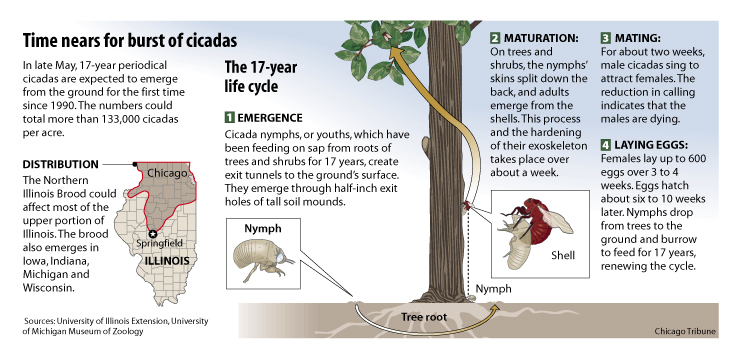 Brace yourselves, Chicagoland, because the cicadas are back! The Chicago Tribune recently published an article about the upcoming infestation of cicadas (which happen to be in the Arthropod phylum).
Brace yourselves, Chicagoland, because the cicadas are back! The Chicago Tribune recently published an article about the upcoming infestation of cicadas (which happen to be in the Arthropod phylum).Cicadas are often mistaken for locusts, but they're actually they are related to leafhoppers or aphids. (Watch a video of actual locusts here.) Locusts are grasshoppers that often travel in vast swarms. Because periodical cicadas appear in such large numbers, early European settlers in North America connected cicadas to the plague of locusts mentioned in the Bible. Cicadas are not locusts.

There are some great articles to help you learn how cicadas work. Basically, they work on a 17 or 13 year life cycle. They won't hurt you. Cicadas do not sting or bite, and their diet consists of the sap from plants. The very loud sound you will hear (mostly during the heat of the day) is actually the mating call of the male cicadas. The sound is not produced by vocal chords, but rather by the buckling of the ribs, the vibration of a membrane and amplification in the cavities of the cicada's abdomen. (You can visit the University of Michigan zoology site to find audio files from various types of cicadas.)
After they sing, the cicadas mate. Afterwards, adult female cicada lay eggs by piercing plant stems and inserting the eggs into the slit created in the stem. The eggs eventually hatch into small, wingless cicadas known as nymphs. The nymphs eventually fall to the ground and dig below the surface. Here they stay for 17 years, slowly growing into adults. The nymphs live on the sap from plant roots while they grow. When the nymphs reach full size, they dig their way to the surface with specially adapted front legs that act as tiny shovels. The nymphs then climb to higher ground and shed their skin for the last time. (see YouTube video) Now they are fully-winged adult cicadas. - How Stuff Works
Watch an amazing movie on the life cycle of cicadas.
There are two main types of cicadas: "annual" cicadas, which are around in small numbers each year, and "periodical" cicadas, which come out in a giant, synchronized mass every 13 or 17 years. I learned that there are believed to be 13 broods of 17-year cicadas in North America. (I also learned you won't find periodical cicadas on any other continent!) The respective 17 and 13 year broods of any one species only overlap once every 221 years, i.e. broods V and XXII emerged synchronously in 1897 and will not do so again until 2118." (source: Gordon's Cicada Page) Check out this great interactive map to learn more about broods and when they might be in your area!The last brood to emerge was Brood X (brood #10), which came up in the spring of 2004 in the eastern US. The group of cicadas that will be seen in Chicago this May are named Brood XIII (or brood #13). The last time they surfaced (if you do a little mental math) was in 1990, when I was a freshman in high school! Hey, to celebrate this historic moment in your middle school lives, you may want to order your Brood XIII T-shirts now!
They will surface when the ground temperature reaches about 60 degrees Fahrenheit. With any luck, they will be here just in time for all those Memorial Day picnics....
More information on Brood XII (and local cicada events) can be found on the following sites:
Great presentation from Indiana University
The Lake County Forest Preserve
The University of Illinois Cicada Page
ABC News (with video)
Cicada Mania
And, it's not very nice, but you can play Swat the Cicada on your computer.
The University of Maryland even provides cicada recipes for your dining pleasure. It is said they taste like asparagus or clam-flavoured potato.NPR posts just one of their many recipes: (whoa - read the "before you begin")
Disclaimer: the University of Maryland does not advocate eating cicadas without first consulting with your doctor. While many people do eat cicadas, there is no guarantee that they are safe for every person to eat. As with all foods, it is possible that certain individuals will have allergic reactions to substances within the cicada.
Soft-Shelled Cicadas
Ingredients:
1 cup Worcestershire sauce
60 freshly emerged 17-year cicadas
4 eggs, beaten
3 cups flour
Salt and pepper to season the flour
1 cup corn oil or slightly salted butter
Directions:
Marinate cicadas alive in a sealed container in Worcestershire sauce for several hours. (Note: You can skip this step and go directly to the egg step instead.)
Dip them in the beaten egg, roll them in the seasoned flour and then gently sauté until they are golden brown.


1 comment:
I couldn't find an e-mail address for you, so I apologize for posting here. If you'd like a full-size shot of those cicadas (suitable for printing -- or displaying really big to gross out your students).
I also have video of a walk through a Brood X-infested forest. I could send you a 30-second snippet just so you could hear the incredible racket they make.
Lemme know if you're interested. I'm happy to send 'em.
Andrew Kantor
Post a Comment